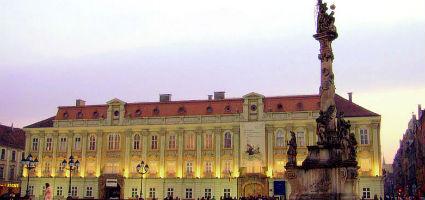2026. January 7. Wednesday
Temesvár Fine Art Museum - Timişoara
 |
Address: 300085, Timişoara P-ţa Unirii nr. 1
Phone number: (256) 491-592
E-mail: muzeuldeartatm@clicknet.ro
Opening hours: Tue-Sun 10-18
The "European Paintings" permanent exhibition is closed at the moment due to resurrection! |
Museum tickets, service costs:
|
Ticket for adults
|
5 HUF
|
|
|
Ticket for students
|
1 HUF
|
|
|
Ticket for pensioners
|
1 HUF
|
|
|
Photography
|
10 HUF
|
|
|
Video
|
20 HUF
|
Corneliu Baba was born in Craoive in Olténia in 1906 as the third son of Gheorghe Baba, a church painter of Karánsebes and Mathilda Baba. He moved to Temesvár after graduating from the Faculty of Arts of the University of Bucurest, at the beginning of the 1930's. Though he met several progressive artists, these three years of his life were spent with searching his own path.
He held his first exhibition with his father at Herkulesfürdő in 1934 where the lawyer Omar Popovici from Jászvásári (Iaşi) noticed him. He advised Corneliu Baba to enrol at the Academy of Arts of Moldova, in the class led by Nicolae Tonitza. Even though he had planned to spend two-three months at Jászvásár, he changed his mind and spent 16 years at the university where he became a professor.
He was influenced by the art of Tonitza, Grigorescu, as well as El Greco, Goya and Rembrandt. Later on he painted self-portraits, portraits and series (eg. about the mad king Arlekino). However, he was socially sensitive in his topics too. On top of that, he left a number of landscapes, townscapes and still loves to posterity. His artworks can be found in Tokyo, Moscow, Berlin, Budapest, Brussels and New York. He was member of the Romanian Academy of Science, honorary member of the Russian Academy of Arts and correspondence of the Academy of Berlin. He died in Bucharest in 1997.
It is important to notice that the pictures shown at his exhibition at the Museum of Fine Arts in Temesvár are not all owned by the museum.
He held his first exhibition with his father at Herkulesfürdő in 1934 where the lawyer Omar Popovici from Jászvásári (Iaşi) noticed him. He advised Corneliu Baba to enrol at the Academy of Arts of Moldova, in the class led by Nicolae Tonitza. Even though he had planned to spend two-three months at Jászvásár, he changed his mind and spent 16 years at the university where he became a professor.
He was influenced by the art of Tonitza, Grigorescu, as well as El Greco, Goya and Rembrandt. Later on he painted self-portraits, portraits and series (eg. about the mad king Arlekino). However, he was socially sensitive in his topics too. On top of that, he left a number of landscapes, townscapes and still loves to posterity. His artworks can be found in Tokyo, Moscow, Berlin, Budapest, Brussels and New York. He was member of the Romanian Academy of Science, honorary member of the Russian Academy of Arts and correspondence of the Academy of Berlin. He died in Bucharest in 1997.
It is important to notice that the pictures shown at his exhibition at the Museum of Fine Arts in Temesvár are not all owned by the museum.